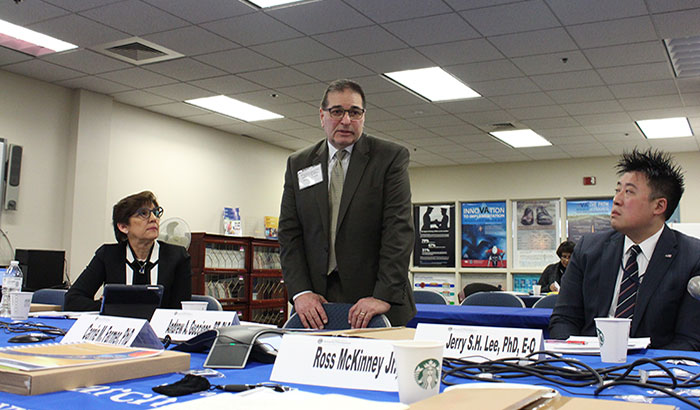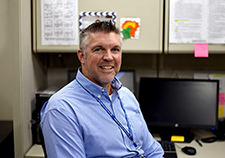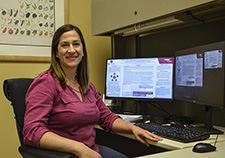Office of Research & Development |
 |


NRAC member Dr. Andrew Guccione addresses his colleagues during the group’s winter 2018 meeting. (Photo by Mitch Mirkin)
March 28, 2018
By Mike Richman
VA Research Communications
Advisory committees have long played a critical role in shaping the policies, programs, and direction of federal agencies. Composed mostly of experts from academia and the private sector, these committees give government officials and the public advice and access to information on many issues affecting federal initiatives.

The NRAC is one of nearly 30 advisory committees that help guide VA programs and policies. (Photo by Mitch Mirkin)
Nearly 30 advisory committees help guide VA programs and policies. One of them is the National Research Advisory Council, or NRAC, which was created in 1999 to provide external review of VA’s research mission. NRAC advises the VA secretary on research sponsored or conducted by the agency, including policies and programs of VA’s Office of Research and Development (ORD), and makes recommendations to ORD.
Normally consisting of 12 members with distinguished scientific backgrounds, the council brings a wealth of experience that helps shape new programs and priorities for VA research. That research targets the high-priority health care needs of Veterans.
“This group is absolutely critical both to respond to ideas that may be emanating from VA staff and to suggest priorities,” says NRAC member Dr. Andrew Guccione, chair of the department of rehabilitation science at George Mason University in Virginia. “Certainly in the last two years, we’ve stressed the importance of getting the message out. That has made ORD increase its public communications.”
He adds: “There is much good that happens through VA research but, even if the public finds out about it, they may not know it came from VA. There has been the desire that Congress also know what is coming out of the VA research programs. VA is such a large system and a huge research enterprise.”
"Reaching out to academic experts in research and medicine provides a much-needed perspective that can be beneficial."
NRAC falls under the purview of VA’s Advisory Committee Management Office, which oversees the agency’s 29 advisory committees, 17 of which were mandated by Congress. NRAC is one of the 12 that was established at the direction of the VA secretary.
Council members are appointed to a two-year term, with the option to be chosen for another two years. Five of the 12 members serving in the 2018 to 2020 session are in their second term, such as Guccione.

VA ear surgeon studies management of severe hearing loss in Veterans

Veteran disability payments led to fewer hospitalizations

Air Force Veteran among 10 new awardees in VA diversity, equity, and inclusion research program

VA researcher leads project to evaluate Veteran screening for malnutrition
All members, including the NRAC chair, are recommended by ORD staff in a rigorous selection process. VA’s chief research and development officer (CRADO) then nominates the candidates, whose names are sent to the VA secretary for final approval.
Most of the panel consists of non-federal employees; two current members are affiliated with government agencies: Dr. Yvonne Maddox of the Uniformed Services University of the Health Sciences and Dr. Jerry Lee of the National Cancer Institute.
ORD seeks diversity in selecting NRAC members. Categories of expertise that may be represented are biomedical research, clinical research, primary care, geriatric care, health issues affecting special populations of Veterans, mental health and behavioral research, occupational and environmental health research, and surgery research. The current panel’s areas of focus include traumatic brain injury, PTSD, cardiovascular physiology, genetics, and chemical and microbiology engineering.
The council represents, to the extent possible, Veterans of multiple branches of service and populations with regard to race, ethnicity, gender, religion, disabilities, and geographical background.
NRAC membership must include at least one Veteran to provide perspective on the health needs of former military. Three current members are Veterans: NRAC Chairman Dr. David Young, a retired Air Force brigadier general; Dr. Geoffrey Ling, a retired Army colonel and a professor of neurology at Johns Hopkins University in Baltimore; and Dr. Boris Lushniak, dean of the University of Maryland’s school of public health. Lushniak is a retired U.S. Public Health Service Commissioned Corps rear admiral and has served as acting and deputy U.S. surgeon general.
Each year, NRAC updates the VA secretary on ORD’s management of the agency’s research program. In its latest review, which covered 2017, the council gave ORD high marks and said its “comprehensive research program served VA’s commitment to the health and care of Veterans through several cutting-edge programs focused on [VA’s] top priorities.”
In a letter signed by former NRAC chairman Dr. John Feussner, the council cited a series of VA research achievements, including a suicide prevention program called Recovery Engagement and Coordination for Health—Veterans Enhanced Treatment, or REACH VET. The initiative, launched in 2017, uses predictive modeling and medical record data to identify Veterans at the highest risk of suicide.
NRAC also noted that ORD continued to grow the Million Veteran Program (MVP), a voluntary research endeavor funded by ORD that partners with Veterans receiving VA health care to study how genes affect health. MVP officials say Veteran enrollment stood at more than 650,000 as of March 2018, noting that the program is on target to reach 1 million by 2021.
The council also made three recommendations that were “accepted by ORD leadership for implementation as appropriate,” according to NRAC.
Young notes that a “recurrent theme” within NRAC is the need for more and better cooperation between VA and the Department of Defense (DoD). In an example of bi-agency collaboration, he praises VA’s plan to transition from its electronic medical records program, the Computerized Patient Record System (CPRS), and adopt DoD’s electronic medical records system to allow for seamless care between VA and DoD.
“If you put DoD health care and VA together and include that with what [VA Secretary] Dr. David Shulkin has done with VA’s electronic medical records system, you now have the largest health care system in the world,” Young says. “If that database becomes accessible to VA and DoD [researchers], you have the largest research platform.”
Rick Starrs is chief executive officer of the National Association of Veterans’ Research and Education Foundations, which consists of research and education foundations affiliated with VA medical centers. He says it’s “incredibly important” for ORD to exchange thoughts with private-sector experts on the direction of VA research. Input from the NRAC panel provides a dimension of suggestions and expertise that ultimately helps Veterans, he adds.
“There’s always the threat of federal organizations being very inwardly focused and not understanding what outsiders can offer and the assistance they can provide,” Starrs says. “Reaching out to academic experts in research and medicine provides a much-needed perspective that can be beneficial.”
VA Research Currents archives || Sign up for VA Research updates